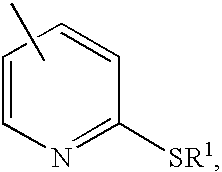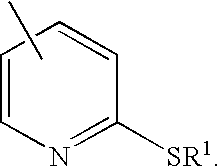Derivatives of isosorbide mononitrate and its use as vasodilating agents with reduced tolerance
- Summary
- Abstract
- Description
- Claims
- Application Information
AI Technical Summary
Benefits of technology
Problems solved by technology
Method used
Image
Examples
example 1
Obtaining isosorbide 2-(2′-ethylthio)nicotinate 5-mononitrate hydrochloride(1).
Step 1.—In a 50 mL glass flask, provided with a reflux refrigerator, closed with a CaCl2 tube, and magnetic agitation, 4.25 g (23.2 mmol) 2-ethylthionicotinic acid are dissolved in 20 mL. of thionyl chloride (1.64 g / ml; 275.6 mmol). The reaction mixture is refluxed for 3.5 h. After this period, the mixture is cooled down and excess thionyl chloride is eliminated under reduced pressure while adding portions of toluene. After drying at reduced pressure, 4.67 g of a yellowish solid corresponding to the acid chloride of interest are obtained. Yield: 100%.
Step 2.—In a 50 ml glass flask, provided with magnetic agitation and reflux refrigerator, 4.67 g (23.2 mmol) of the acid chloride obtained in the step above are dissolved, under Ar atmosphere, in 25 ml pyridine. The solution is cooled down in a ice bath and 4.44 g (23.2 mmol) of isosorbide 5-mononitrate are added. The reaction mixture is agitated at room temp...
example 2
Obtaining Isosorbide 5-(2′-ethylthio)nico-tinate 2-mononitrate hydrochloride(2).
Step 1.—The same method as in step 2 of example 1 is used, applying as starting product the isosorbide 2-mononitrate. The product of interest is obtained at a chemical yield of 88%.
Step 2.—In a 500 ml three necked glass flask provided with a reflux refrigerator stopped with a CaCl2 tube, magnetic agitation, and an addition funnel of compensated pressure, 7.0 g (19.66 mmol) of the product obtained in the former step are dissolved in a mixture of 200 mL of EtOEt+100 mL of CH2Cl2. The solution is agitated at room temperature and 30 mL of EtOEt solution saturated with HCl (solution prior prepared bubbling HCl gas directly into the EtOEt until saturation) are added, drop by drop, producing a white solid precipitate. The solid is filtered and washed with an excess of EtOEt and dried at reduced pressure. 7.05 g of the product of interest are obtained. Yield: 91%.
1H-NMR (200 MHz, DMSO-d6): 8.63 (1H, dd, J=5 Hz, ...
example 3
Obtaining isosorbide 2-(2′-mercapto)nicotinate 5-mononitrate (3)
Step 1.—In a 100 mL glass flask, provided with a reflux refrigerator stopped with a CaCl2 tube and magnetic agitation, 3.0 g (19.35 mmol) of 2-mercaptonicotinic acid are suspended in 30 mL of thionyl chloride (1.64 g / ml; 413.4 mmol). The mixture is left to reflux for 2h, observing the dissolution of the solid during this period. The mixture is cooled down and the excess of thionyl chloride is eliminated under reduced pressure while adding portions of toluene. After drying at reduced pressure, 3.35 g of a yellow-orange solid corresponding to the acid chloride of interest are obtained. Yield, 100%.
Step 2.—In a 250 mL glass flask, provided with a reflux refrigerator and magnetic agitation, 3.0 g (17.29 mmol) of the acid chloride obtained in the former step are suspended, under Ar atmosphere, in 75 mL of pyridine. The suspension is cooled down in an ice bath and 3.30 g (17.29 mmol) of isosorbide 5-mononitrate are added. The...
PUM
| Property | Measurement | Unit |
|---|---|---|
| Mass | aaaaa | aaaaa |
| Mass | aaaaa | aaaaa |
| Molar density | aaaaa | aaaaa |
Abstract
Description
Claims
Application Information
 Login to View More
Login to View More - R&D
- Intellectual Property
- Life Sciences
- Materials
- Tech Scout
- Unparalleled Data Quality
- Higher Quality Content
- 60% Fewer Hallucinations
Browse by: Latest US Patents, China's latest patents, Technical Efficacy Thesaurus, Application Domain, Technology Topic, Popular Technical Reports.
© 2025 PatSnap. All rights reserved.Legal|Privacy policy|Modern Slavery Act Transparency Statement|Sitemap|About US| Contact US: help@patsnap.com



